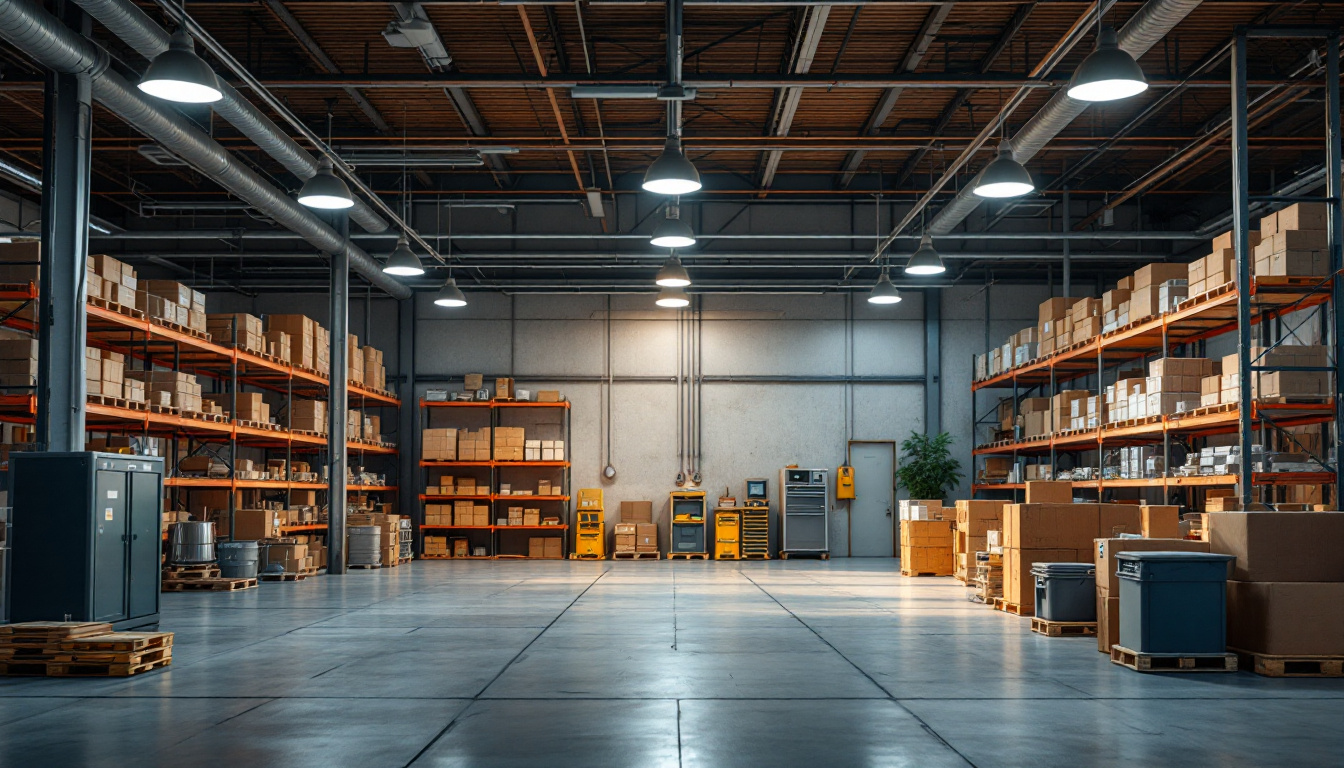
In the realm of warehouse lighting, the importance of selecting the right number of fixtures cannot be overstated. It is a critical aspect that often gets overlooked, leading to inefficient lighting setups that can affect productivity, safety, and energy consumption. This article delves into the factors that determine how many fixtures are necessary for a given warehouse space, providing valuable insights for lighting contractors.
Before diving into the specifics of fixture quantities, it’s essential to understand the unique requirements of warehouse lighting. Warehouses are typically large, open spaces that serve various functions, from storage to assembly. The lighting needs can vary significantly based on the activities taking place within these spaces. For instance, a warehouse dedicated to storing delicate items may require softer, more diffused lighting to prevent damage, while a distribution center might need brighter, more focused lighting to facilitate quick and accurate order fulfillment.
Task lighting is crucial in areas where specific activities occur, such as assembly lines or packing stations. These areas may require higher illumination levels to ensure safety and efficiency. Understanding the tasks performed in different zones of the warehouse can help determine the type and number of fixtures needed. For example, in a packing area, adjustable task lights can be beneficial, allowing workers to direct light exactly where it’s needed, thereby reducing eye strain and increasing productivity. Moreover, the use of LED task lights can offer energy efficiency, reducing operational costs while providing optimal visibility.
In addition to task lighting, general ambient lighting is necessary to provide a uniform light level throughout the warehouse. This lighting helps prevent shadows and dark spots, which can lead to accidents. The ambient light level should be sufficient to allow workers to navigate the space safely. Utilizing high-efficiency fixtures, such as LED high bays, can enhance ambient lighting while minimizing energy consumption. Furthermore, incorporating smart lighting systems that adjust based on occupancy can further optimize energy use and ensure that areas are well-lit only when needed, thus contributing to a more sustainable operation.
Compliance with lighting standards is another critical factor. Organizations such as the Illuminating Engineering Society (IES) provide guidelines on recommended light levels for various environments, including warehouses. Adhering to these standards ensures that the lighting not only meets safety requirements but also enhances productivity. Regular audits of lighting conditions can help maintain compliance and identify areas for improvement. Additionally, staying updated with advancements in lighting technology can provide opportunities for upgrades that enhance both safety and efficiency, ensuring that the warehouse remains a productive environment for all employees.
Calculating the number of fixtures needed for a warehouse involves several key factors, including the size of the space, the type of fixtures being used, and the desired light levels. A systematic approach will yield the most accurate results.
The first step in calculating fixture requirements is to measure the dimensions of the warehouse. This includes the length, width, and height of the space. Understanding the total square footage is essential, as it will serve as the basis for further calculations. Additionally, it is important to consider any architectural features, such as columns or overhead equipment, that may obstruct light distribution. These elements can significantly influence the placement and number of fixtures needed to ensure an even light distribution throughout the area.
Once the dimensions are known, the next step is to determine the desired light levels for different areas of the warehouse. This is typically measured in foot-candles (fc). For example, general storage areas may require around 10-20 fc, while areas with more intricate tasks may need 30-50 fc or more. Establishing these levels will guide the selection of appropriate fixtures. It is also beneficial to consult industry standards or guidelines, such as those provided by the Illuminating Engineering Society (IES), to ensure compliance with best practices for specific tasks, such as picking, packing, or assembly operations. This ensures that the lighting not only meets regulatory requirements but also enhances productivity and safety in the workspace.
The type of fixtures selected will also impact how many are needed. LED fixtures, for example, are more efficient and provide higher lumen output compared to traditional fluorescent lights. Understanding the lumen output of the chosen fixtures will help in calculating how many are required to achieve the desired light levels. Furthermore, considering the color temperature of the fixtures can significantly affect the ambiance and functionality of the warehouse. Warmer light temperatures may be more suitable for areas where employees spend extended periods, while cooler temperatures can enhance alertness and focus in high-activity zones. It’s also wise to factor in the longevity and maintenance of the fixtures, as investing in durable options can lead to lower long-term costs and less frequent replacements, ultimately contributing to a more sustainable operation.
Once the number of fixtures is determined, the next consideration is their placement and spacing. Proper fixture placement is essential for achieving uniform lighting throughout the warehouse. An effective lighting layout not only enhances visibility but also contributes to safety and productivity, making it a critical aspect of warehouse design.
One common method for placing fixtures is to use a grid layout. This involves evenly spacing fixtures across the ceiling to ensure that light is distributed uniformly. The spacing between fixtures will depend on their lumen output and the height of the ceiling. A general rule of thumb is to space fixtures at a distance equal to 1.5 times the height of the fixture from the floor. Additionally, considering the type of activities conducted in different sections of the warehouse can further refine this layout. For instance, areas designated for detailed work may require closer spacing to provide more focused illumination, while storage zones may benefit from broader spacing.
Obstructions such as shelving, machinery, or structural elements can affect light distribution. It’s important to account for these when planning fixture placement. Adjustments may be necessary to avoid shadows and ensure that all areas are adequately lit. Furthermore, the use of reflective surfaces can enhance light distribution. For example, installing light-colored walls or ceilings can help bounce light around the space, reducing the need for additional fixtures and creating a brighter environment overall.
Lighting design software can be a valuable tool in this process. These programs allow contractors to simulate lighting scenarios, helping to visualize how different placements will affect the overall illumination. This can lead to more informed decisions and ultimately better lighting outcomes. Moreover, many of these software solutions come equipped with features that analyze energy consumption and cost-efficiency, enabling warehouse managers to make choices that not only improve lighting quality but also optimize operational costs. By integrating these technological tools into the planning phase, businesses can ensure their lighting strategy aligns with both functional and financial goals.
In today’s environmentally conscious landscape, energy efficiency is a critical consideration in lighting design. Selecting the right fixtures and optimizing their placement can lead to significant energy savings.
LED fixtures are often the go-to choice for energy efficiency. They consume less power and have a longer lifespan compared to traditional lighting options. By opting for energy-efficient fixtures, contractors can reduce energy costs and minimize the carbon footprint of the warehouse.
Incorporating smart lighting controls can further enhance energy efficiency. Features such as motion sensors, dimmers, and timers can help to ensure that lights are only on when needed. This not only saves energy but also extends the life of the fixtures.
While the initial investment in energy-efficient fixtures may be higher, the long-term savings can be substantial. Evaluating the return on investment (ROI) is crucial for warehouse owners. A thorough analysis can demonstrate how energy-efficient lighting can lead to lower utility bills and reduced maintenance costs over time.
Even seasoned lighting contractors can make mistakes when it comes to determining the number of fixtures needed for a warehouse. Being aware of common pitfalls can help avoid costly errors.
One of the most common mistakes is underestimating the lighting needs of a warehouse. Insufficient lighting can lead to safety hazards and decreased productivity. It’s vital to conduct a thorough assessment of the space and consider all factors before finalizing fixture quantities.
Another mistake is neglecting maintenance considerations. Fixtures that are difficult to access for maintenance can lead to increased downtime and costs. Planning for easy access to fixtures during installation can save time and effort in the long run.
Warehouses are often dynamic environments that may change over time. Ignoring potential future needs can result in inadequate lighting as operations evolve. It’s wise to consider flexibility in the lighting design to accommodate changes in layout or function.
Determining the right number of warehouse fixtures is a multifaceted process that requires careful consideration of various factors. From understanding the unique lighting requirements of the space to calculating fixture quantities and ensuring energy efficiency, each step plays a crucial role in the overall success of a lighting project.
By avoiding common mistakes and leveraging modern tools and technologies, lighting contractors can create effective lighting solutions that enhance safety, productivity, and energy efficiency in warehouse environments. Ultimately, the right approach to warehouse lighting can transform a space, making it more functional and conducive to the tasks at hand.
In summary, understanding how many fixtures are needed for a warehouse space is not just a technical requirement; it is a vital piece of the puzzle that can significantly impact the effectiveness of lighting projects. By taking the time to assess the needs of the space and applying best practices in fixture selection and placement, contractors can ensure that their lighting designs meet the demands of modern warehouses.
Ready to elevate your warehouse lighting project with the right fixtures at unbeatable prices? Look no further than LumenWholesale for a vast selection of top-quality, spec-grade lighting solutions. Our commitment to cutting out the middleman means you get the best value without inflated markups. Plus, with free shipping on bulk orders, you can trust that you’re getting premium lighting at the most competitive prices, hassle-free. Don’t compromise on quality or cost—choose LumenWholesale for the perfect blend of affordability, convenience, and high-performance lighting for your next project.

Discover the essential checklist for lighting contractors to master LED lighting for signage.

Discover why lighting contractors should prioritize pot lights in their projects.

Explore the advantages and challenges of commercial LED lighting for contractors.

Discover how lighting contractors are transforming spaces with affordable vanity light fixtures.